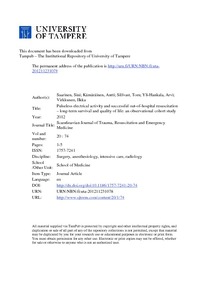Pulseless electrical activity and successful out-of-hospital resuscitation – long-term survival and quality of life: an observational cohort study
Saarinen, Sini; Kämäräinen, Antti; Silfvast, Tom; Yli-Hankala, Arvi; Virkkunen, Ilkka (2012)
Saarinen, Sini
Kämäräinen, Antti
Silfvast, Tom
Yli-Hankala, Arvi
Virkkunen, Ilkka
2012
Scandinavian Journal of Trauma, Resuscitation and Emergency Medicine 20
74
Lääketieteen yksikkö - School of Medicine
This publication is copyrighted. You may download, display and print it for Your own personal use. Commercial use is prohibited.
Julkaisun pysyvä osoite on
https://urn.fi/URN:NBN:fi:uta-201211231078
https://urn.fi/URN:NBN:fi:uta-201211231078
Kuvaus
BioMed Central Open access
Tiivistelmä
Background
The aim of the study was to evaluate the long-term outcome of patients successfully resuscitated from pre-hospital cardiac arrest with initial pulseless electrical activity (PEA), because the long-term outcome of these patients is unknown. Survival, neurological status one year after cardiac arrest and self-perceived quality of life after five years were assessed.
Methods
This retrospective study included adult patients resuscitated from PEA between August 2001 and March 2003 in three urban areas in southern Finland. A validated questionnaire was sent to patients while neurological status according to the Cerebral Performance Category (CPC) -classification was assessed based on medical database notes recorded during follow-up evaluations.
Results
Out of 99 included patients in whom resuscitation was attempted, 41 (41%) were successfully resuscitated and admitted to hospital. Ten (10%) patients were discharged from hospital. Seven were alive after one year and six after five years following cardiac arrest. Five of the seven patients alive one year after resuscitation presented with the same functional level as prior to cardiac arrest.
Conclusions
Patients with initial PEA have been considered to have poor prognosis, but in our material, half of those who survived to hospital discharge were still alive after 5 years. Their self-assessed quality of life seems to be good with only mild to moderate impairments in activities of daily life.
The aim of the study was to evaluate the long-term outcome of patients successfully resuscitated from pre-hospital cardiac arrest with initial pulseless electrical activity (PEA), because the long-term outcome of these patients is unknown. Survival, neurological status one year after cardiac arrest and self-perceived quality of life after five years were assessed.
Methods
This retrospective study included adult patients resuscitated from PEA between August 2001 and March 2003 in three urban areas in southern Finland. A validated questionnaire was sent to patients while neurological status according to the Cerebral Performance Category (CPC) -classification was assessed based on medical database notes recorded during follow-up evaluations.
Results
Out of 99 included patients in whom resuscitation was attempted, 41 (41%) were successfully resuscitated and admitted to hospital. Ten (10%) patients were discharged from hospital. Seven were alive after one year and six after five years following cardiac arrest. Five of the seven patients alive one year after resuscitation presented with the same functional level as prior to cardiac arrest.
Conclusions
Patients with initial PEA have been considered to have poor prognosis, but in our material, half of those who survived to hospital discharge were still alive after 5 years. Their self-assessed quality of life seems to be good with only mild to moderate impairments in activities of daily life.
Kokoelmat
- Artikkelit [6140]
